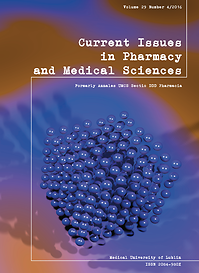The survival of dental implants with different implant-abutment connection systems
DOI:
https://doi.org/10.1515/cipms-2016-0003Keywords:
dental implants, dental abutment, survival analysisAbstract
The aim of the study was to evaluate the survival of implants with different implant-abutment connection systems, in patients who had two kinds of implants implanted. In total, 240 implants were implanted - 91 implants with conical abutment Morse connection, and 149 with an internal hexagonal connection. During the follow-up period of 3 years and 10 months, the percentage of lost implants with a conical implant-abutment connection was 1.1%. Regarding the implants with hexagonal implant-abutment connection, this figure was 0.7%. Our work shows that there is a need for further research on the survival of dental implants. In this, the influence of other factors should be explored that are related both to the specific implant treatment, as well as to socio-demographic factors.
References
1. Chou C.T.S.: AICRG Part II: Crestal bone loss associated with the ANKYLOS implant: loading to 36 months. J. Oral Implantol., 30, 134, 2004.
2. Döring K., Eisenmann E., Stiller M.: Functional and esthetic considerations for single-tooth ANKYLOS® implant-crowns: 8 years of clinical performance. J. Oral Implantol., 30, 198, 2004.
3. Koszuta A., Szymańska J.: The level of patient satisfaction with implant treatment of missing teeth. Curr. Issues Pharm. Med. Sci., 25, 243, 2012.
4. Levin L. et al.: Long-term marginal bone loss around single dental implants affected by current and past smoking habits. Implant Dent., 17, 422, 2008.
5. Levin L., Sadet P., Grossmann Y.: A retrospective evaluation of 1,387 single-tooth implants: a 6-year follow up. J. Periodontol., 77, 2080, 2006.
6. Lin Y. et al.: A clinical retrospective study of 10 years of implant results. Chin. J. Stomatol., 41, 131, 2006.
7. Machtei E.E. et al.: Dental implants for immediate fixed restoration of partially edentulous patients: a 1-year prospective pilot clinical trial in periodontally susceptible patients. J. Periodontol., 78, 1188, 2007.
8. Maló P., Nobre M., Lopes A.: The rehabilitation of completely edentulous maxillae with different degrees of resorption with four or more immediately loaded implants: a 5-year retrospective study and a new classification. Eur. J. Oral Implantol., 4, 227, 2011.
9. Mertens C. et al: Use of 8-mm and 9-mm Implants in Atrophic Alveolar Ridges: 10-Year Results. Int. J. Oral Maxillofac. Implants, 27, 1501, 2012.
10. Morris H.F. et al.: AICRG Part I: A 6-year multicentered, multidisciplinary clinical study of a new and innovative implant design. J. Oral Implantol., 30, 125, 2004.
11. Myśliwiec L. et al.: Leczenie implantoprotetyczne wrodzonego braku drugich siekaczy w szczęce. Implantoprotetyka, 8, 39, 2007.
12. Nentwig G-H.: The ANKYLOS® implant system: concept and clinical application. J. Oral Implantol., 30, 171, 2004.
13. Rasouli Ghahroudi A.A.R. et al.: Radiographic vertical bone loss evaluation around dental implants following one year of functional loading. J. Dent., 7, 89, 2010.
14. Schwartz-Arad D. et al.: Smoking and complications of endosseous dental implants. J. Periodontol., 73, 153, 2002.
15. Stupka M.: Przykłady zastosowania wszczepów dentystycznych w różnych przypadkach braków zębowych. Część pierwsza – etap chirurgiczny. Implantoprotetyka, 30, 17, 2008.
16. Stupka M.: Przykłady zastosowania wszczepów dentystycznych w różnych przypadkach braków zębowych. Część druga – etap protetyczny. Implantoprotetyka, 30, 23, 2008.
17. Tandlich M. et al.: Removable prostheses may enhance marginal bone loss around dental implants: a long-term retrospective analysis. J. Periodontol., 78, 2253, 2007.
18. Vandeweghe S., Bruyn H.: The effect of smoking on early bone remodelling on surface modified Southern Implants®. Clin. Implant Dent. Relat. Res., 13, 206, 2011.
19. Winkler S., Morris H.F., Ochi S.: Implant survival to 36 months as related to length and diameter. Ann. Periodontol., 5, 22, 2000.
Downloads
Published
Issue
Section
License
Copyright (c) 2016 Authors

This work is licensed under a Creative Commons Attribution-NonCommercial-NoDerivatives 3.0 Unported License.


